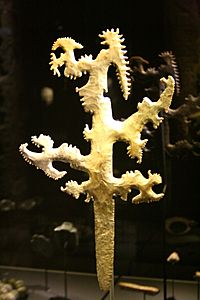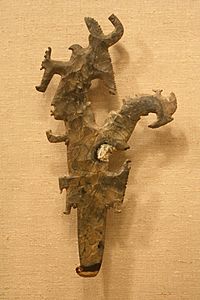Eccentric flint facts for kids
An eccentric flint is a unique stone tool made by the ancient Maya people. These tools often have unusual or "eccentric" shapes. Even though they are called "flints," they were usually made from other strong stones. These include chert, chalcedony, and a dark, glassy rock called obsidian.
Contents
Where Were Eccentric Flints Found?
Archaeologists first found and studied eccentric flints in Belize in the early 1900s. They quickly realized these were special objects used in ceremonies. Most eccentric flints have been discovered in the eastern part of the main Maya area. This includes the Petén Department in Guatemala and nearby Belize.
Very few have been found in the western Maya lands or the Yucatán Peninsula. It is also rare to find them in the Guatemalan Highlands. This suggests they were probably not made there. Some small obsidian eccentrics were even found far away at Teotihuacan. This was a huge ancient city in the Valley of Mexico.
What Do Eccentric Flints Look Like?
Eccentric flints are some of the most beautiful stone objects made by the ancient Maya. They were very hard to create. The people who made them needed amazing skill. Some large obsidian eccentrics can be longer than 30 centimetres (12 in).
Their shapes are very different from one another. But they often show human figures, animals, or geometric designs. These shapes usually relate to Maya religion and beliefs.
What Were Eccentric Flints Used For?
Most eccentric flints have been found in special hidden places called caches. These caches were buried under Maya monuments and buildings. For example, under an altar in Copan, three identical eccentric flints were found. Each one looked like a human figure with a long handle part. They also had six human heads growing from them.
Nine more eccentric flints were found in an early temple room in Copan. These also looked like human figures with handle parts. They were wrapped in a deep blue cloth. The handle parts suggest that these flints might have been attached to a stick or handle. Perhaps they were the top of a royal staff or the blade of a special axe.
Some eccentric flints were too big or oddly shaped to be carried around. These might have been made just to be buried as offerings to the gods.
What Figures Do They Show?
Eccentric flints show many different shapes. Some look like crescent moons, crosses, snakes, or scorpions. The biggest and most detailed ones often show many human heads. Sometimes smaller heads even branch off from larger ones (see Fig. 1).
The human faces on these flints are usually young and have simple outlines. They often show a sloped forehead and distinct lips. Many also have a symbol on the forehead that looks like a smoking torch. This symbol stands for lightning (see Fig. 2). Because of this, these human faces are often thought to be forms of the lightning god, God K. More specifically, they might show the Maize God as a lightning deity. This suggests they had a role in protection.
Eccentric flints that show the lightning god himself are also found, but less often. Some flints even combine both human and God K faces. One very famous eccentric flint is believed to show a "crocodile canoe." This canoe is carrying the spirit of a dead person.



